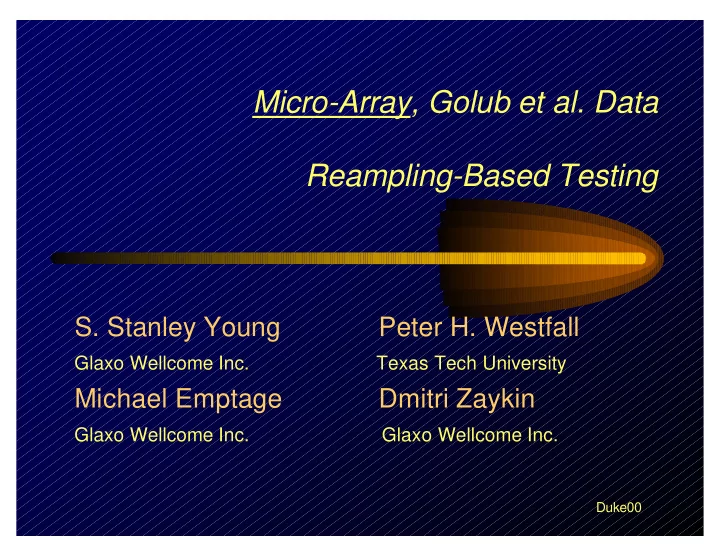

Micro-Array, Golub et al. Data Reampling-Based Testing S. Stanley Young Peter H. Westfall Glaxo Wellcome Inc. Texas Tech University Michael Emptage Dmitri Zaykin Glaxo Wellcome Inc. Glaxo Wellcome Inc. Duke00
Outline 1. Micro array data 2. Problem statement 3. Statistical methods 4. Results 5. Questions Duke00 2
Why micro array data? Business and Science Drivers • Drug target selection • Bio network understanding • Reduce drug development costs Duke00 3
Why micro array data? Knowledge and technology converge • Human Genome Project(s) • Bio chip technology • Informatics Duke00 4
Three Statistical Analysis Problems 1. Correlated genes (guilt by association). 2. General genetic structure. 3. Biology / gene associations. Duke00 5
Goal: Understand gene-phenotype relationships - Level gene correlations - Level k gene associations - Level one gene/bio associations - Level k gene/bio associations. Method : Resampling-based testing! Duke00 6
What are the problems? 1. Few statistical experimental units 2. Very many genes 3. Non-normal distributions 4. Phenotype and data quality 5. Statistical methods Duke00 7
Data Formulation Standard Formulation : Phenotype = f(Genotype) Phenotype Genes Duke00 8
Problems with Standard Formultions Standard Formulation : Phenotype = f(Genotype) 1. Gene expression measured with error. 2. Genotype relatively error free. 3. Enormous number of genes. Duke00 9
Solution: switch x and y Genes Trt Statistical Plan : permute Trt at random, and compute Max t over all genes. Duke00 10
Statistical Testing Strategy 1. Treat micro array data as Y vector. 2. Use t-test as score for each gene. 3. Use resampling to evaluate Max t. Duke00 11
Characteristics of method? 1. Identifies individual genes. 2. Adjusts for multiple testing. 3. Preserves correlation structure. 4. Exact p-values, modulo simulation. Duke00 12
Gene Scores X ALL - X AML T = S p 1/11 + 1/27 X ALL - X AML S Golub = SD ALL + SD AML Duke00 13
SAS proc multtest code proc multtest data=gene.espress out=adjp stepperm holm n=10000 noprint; classes disease; test mean(gene1-gene7129); contrast “AML vs ALL” -1 1; run; Duke00 14
SAS code (2) proc sort data=adjp (where=(stppermp le .05)); by raw_p; proc print data=adjp (where=(stppermp le .05)) noobs label; var _var_ raw_p stpbon_p stppermp; run; Duke00 15
Results (1) Gene RawP Holm CMinP GENE3320 1.38e-10 0.000001 0.0001 GENE4847 2.44e-10 0.000002 0.0001 GENE2020 6.58e-10 0.000005 0.0001 GENE1745 1 e- 8 0.000070 0.0004 GENE5039 1 e- 8 0.000072 0.0004 GENE1834 1.5 e- 8 0.000108 0.0005 GENE 461 3.6 e- 8 0.000257 0.0005 GENE4196 6.2 e- 8 0.000438 0.0009 GENE3847 7.2 e- 8 0.000510 0.0010 Duke00 16
Results (1) Gene RawP Holm CMinP GENE2288 8.90e-8 0.000635 0.0011 GENE1249 1.74e-7 0.001239 0.0017 GENE6201 1.76e-7 0.001250 0.0017 GENE2242 1.95e-7 0.001386 0.0020 GENE3258 2.11e-7 0.001500 0.0021 GENE1882 3.19e-7 0.002267 0.0024 GENE2111 3.66e-7 0.002606 0.0027 GENE2121 5.78e-7 0.004115 0.0041 GENE6200 6.23e-7 0.004428 0.0042 GENE6373 8.19e-7 0.005823 0.0058 Duke00 17
Results (3) Gene RawP Holm CMinP GENE6677 0.000003 0.024412 0.0196 GENE4052 0.000004 0.026268 0.0220 GENE1394 0.000005 0.034948 0.0282 GENE6405 0.000005 0.037980 0.0300 GENE248 0.000006 0.045267 0.0346 GENE2267 0.000006 0.046019 0.0352 GENE6041 0.000008 0.055335 0.0421 GENE6005 0.000008 0.056861 0.0428 GENE5772 0.000009 0.063771 0.0471 GENE6378 0.000010 0.067993 0.0500 Duke00 18
Scatterplot Matrix 3500 2500 1500 GENE3320 500 6000 4000 2000 GENE4847 0 3000 2500 2000 1500 GENE2020 1000 500 3000 2000 1000 GENE1745 500 500 150025003500 0 200040006000 500 1500 2500 500 1500 2500 3500 Duke00 19
Current Research Try some sort of linear combination of genes connonical correlation-like? PLS? RP? Q: Which Ys differeniate cancer type? Q: How many real cancer types? Find single gene then correlates to that gene. Then find second orthogonal gene that helps the prediction. Duke00 20
Recommend
More recommend